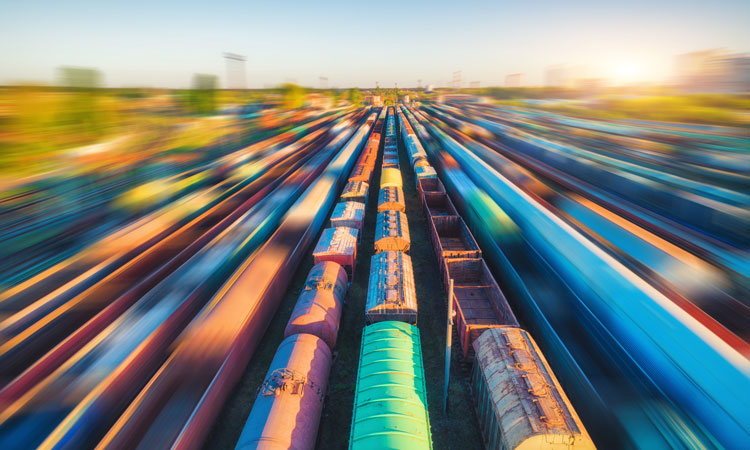Rail freight: from corridors to network at the dawn of a new age of energy scarcity
Posted: 31 October 2022 | Alberto Mazzola, Jacques Dirand | 1 comment
With the looming prospect of energy shortages in Europe, Alberto Mazzola, CER Executive Director, and Jacques Dirand, CER Head of Rail Freight Services, explore the importance of European rail freight corridor regulation and investment.


When the Community of European Railway and Infrastructure Companies (CER) first brought the concept of rail freight corridors into the political arena in 2003, the policy context was on a totally different plane. At the time, the main subject of all political discussions around rail freight was about QUALITY. The quality of rail freight services was perceived as having deteriorated since the early 1990s. The main areas of concern included service punctuality, reliability, speed and price. The European Commission (EC) had already diagnosed the problem in its 2001 whitepaper on ‘European transport policy for 2010: time to decide – COM (2001) 370’ which indeed identified the following three reasons for the lack of quality of rail in general:
- Insufficient infrastructure (including insufficient freight-dedicated infrastructure, taking the American rail system as a possible blueprint for Europe)
- Unbalanced intermodal level playing field, especially in terms of internalisation of external (and internal) costs in road transport
- Lack of intramodal competition, which turned out to be the main focus of European rail policy over the next 10 years.
In the European Parliament, some voices (led by then chair of the Transport Committee, Georg Jarzembowski) were heavily pushing for the liberalisation of the rail freight sector as a primary means to boost rail freight quality. This was based on the, then, overriding belief that market forces would be sufficient to elicit the expected quality jump. At national level, members states were not so keen to admit that there would be a need for substantial investments in rail infrastructure to achieve this objective. On the other hand, the discussions on road charging (Eurovignette) in those days show how reluctant member states have always been to adjust the playing field across transport modes by means of each mode internalising their own costs – whether ‘internal’ or ‘external’.
In 2003, Johannes Ludewig, then CER Executive Director, decided to support Loyola de Palacio, then Transport Commissioner, in her efforts to convince member states to address the lack of investment in rail infrastructure and the unbalanced competitive situation of rail versus other modes. This was done by launching an in-house study on infrastructure investments needs. Considering the short deadline allowed by the fast-moving political discussions, out of six European corridors identified by CER as already or potentially important for rail freight, CER selected three corridors to focus on, with the aim to identify the investments needed to improve rail freight quality and volumes.
However, considering the lack of enthusiasm of the Council and of the European Parliament to address the first two pillars, the only viable avenue that remained open to Transport Commissioner De Palacio was to primarily act on the third pillar: ‘market opening’. As a result, the final legal provisions for the liberalisation of the rail freight market were proclaimed in 2004 as part of the ‘2nd Railway Package’.
However, this did not solve the issue of service quality which, considering the persisting frustration of both shippers expecting quick business wins and the EC and Parliament policymakers expecting quick political returns, remained as topical as ever. Still unclear about the outcome of liberalisation, DG TREN (which later became DG MOVE) came up with the idea of a ‘Rail Freight Quality Regulation’ to force rail operators to deliver quality through a compulsory scheme of penalties to be applied in case of delays. In March 2004, as part of the 3rd Railway Package, the EC issued a ‘regulation proposal on compensation in cases of non‑compliance with contractual quality requirements for rail freight services’, nick-named ‘Freight Quality Regulation Proposal’. CER objected to such a regulation based on the conviction that quality is of purely business relevance. CER also argued that such an initiative would be in contradiction to the liberalisation process, which is based on the fundamental belief that quality should be a result of the interaction of market actors competing against each other. The CER arguments were positively received by the Parliament and the Council who rejected the regulation proposal, forcing the EC to withdraw it.
In parallel, CER continued to pursue its line on the need for authorities to both invest in rail infrastructure and establish a level playing field across modes. In 2007, CER published the results of a study carried out by McKinsey Consulting on infrastructure investments needs. The McKinsey 2007 study, entitled ‘Business Cases for a Primary European Rail Freight Network’, extended the 2003 CER study from three to all six originally defined CER corridors which, in the meantime, had gained official status in EU law as the then called ‘ERTMS Corridors A, B, C, D, E and F’. In short, the McKinsey study demonstrated that on the six ERTMS Corridors (slightly extended to fit with traffic reality at that time), the investment needed to provide enough capacity for freight, and guarantee service quality, is quantified at €145 billion to be spent over a period of 12 years until 2020. McKinsey also provided a split of investments, i.e.,
- €120 billion for infrastructure bottleneck alleviation
- €5 billion to increase infrastructure parameters (e.g., to accommodate longer and heavier trains and higher loading gauges)
- €2 billion on terminal upgrades
- €18 billion on ERTMS deployment.
The McKinsey research concluded that such investment intensity would result in an increase in traffic of close to 75 per cent on the considered corridors.
CER [however], believes that considering energy consumption of rail is seven times lower than road, it is essential to allocate whatever funds remain in the wake of an endemic economic contraction to the transport mode that demonstrates the highest energy performance.
The EC partly relied on these findings to develop what was to later become ‘Regulation 913/2010 on a European Network for Competitive Freight’, nick-named ‘Freight Corridor Regulation’. However, confronted by member states’ reluctance to commit to a regulation that would require them to heavily invest in rail infrastructure in the wake of the ‘crisis of the subprimes’ in 2008, the EC watered down what could have been the foundations of a true European investment masterplan for rail freight into a “mere corridor management tool”. The original intention of CER to push the “corridor approach” as a means to target investments where they were most needed and to coordinate infrastructure works across countries along the main rail freight routes progressively faded away behind a bureaucratic, but more politically acceptable compromise, which more or less proposed to manage the network as if passenger traffic were secondary or non-existent.
It is therefore hardly surprising that, in its evaluation of the regulation published early 2021, the EC recognises that “the Regulation has had a relatively limited impact in achieving its general, specific and operational objectives and has not led to a broad adoption of its tools, and so has delivered the intended effects only to a limited extent.” Neither the governance of the corridors (with their various executive boards, management boards and advisory boards) nor the tools and processes required by the regulation (one-stop-shops, pre-arranged train paths, paths catalogues) lead to a growth of freight traffic or to significant quality improvements. Indeed, as cooperation and coordination were encouraged among national entities along the corridors (especially among infrastructure managers), the nine corridors of the regulation were expected to act as infrastructure managers on lines which they shared with national infrastructure managers. This had the potential to add a layer of complication to daily management, whereas the main role of the corridors should have been, according to CER, to focus on defining infrastructure investments needs and to facilitate the coordination of works on an European level.
Based on these results, the EC decided to revise the rail freight corridor regulation in a two‑step approach:
- The first step was taken in December 2021 with the publication of the Revision of the TEN-T Regulation where the nine ‘European Transport Corridors’ finally integrate the former Core Network Corridors with the Rail Freight Corridors. The new proposal sets up ambitious infrastructure requirements that will have an important impact on the freight business. CER support these goals, but at the same time proposes few improvements, considering the financial limits, as the implementation of the P/C 400 requirements only where needed, as a predefined list of international rail freight routes. The deployment of ERTMS, both on track and on board, will be also a key factor for the development of the freight business, but to succeed a sufficient financial framework must be guaranteed.
- The first step is linked to the revision of the TEN-T Guidelines where it should, according to CER, have belonged straight from the start when the idea of the corridor regulation came up. This phase started in December 2021 as part of the revision of the TEN-T guidelines. Beyond improving the geographical alignment between the TEN-T and the RFC network, it also looks into the practical implementation of the existing TEN-T infrastructure requirements and of new infrastructure parameters such as the loading gauge to accommodate intermodal trains. It also addresses investments to eliminate local bottlenecks. CER fully supports this approach as the Parliament and Council are engaged in first reading.
- The second step is expected to happen early 2023 and will focus on capacity planning and traffic management. CER infrastructure managers and rail operators have engaged in the preparation of this phase via the RailNetEurope project ‘TimeTable Redesign (TTR)’ which proposes new revolutionary IT-based processes to create and allocate capacity on the European rail network.
Combined with a new Digital Capacity Management (DCM), the TTR project has the potential to make the whole rail system move from the limited corridor management mandated by an outdated and inefficient regulation into a modern European network management. This, however, requires legal adaptations that go well beyond the corridor regulation itself and potentially affect provisions of the Single European Rail Area Directive 2012/34 or its annexes.
Prospects
As the revision of the TEN-T Guidelines opens the door to highly welcome changes to the infrastructure-related parts of the freight corridor regulation, experts of the European Energy Agency predict that the peak of overall oil production (conventional and unconventional) has now been reached, opening the prospects of an endemic energy shortage which the current geopolitical situation is, of course, somewhat aggravating. In the face of long-lasting energy scarcity, one may question the relevance to invest in new transport infrastructure, considering that transport is one of the most energy-intensive economic activities. CER however, believes that considering energy consumption of rail is seven times lower than road, it is essential to allocate whatever funds remain in the wake of an endemic economic contraction to the transport mode that demonstrates the highest energy performance.




Issue
Related topics
Related organisations
Community of European Railway and Infrastructure Companies (CER)








Attention yes, but at Bottleneck, the current, elderly, primitive, low price, the devastatingly, high cost infrastructure!
A shift, starting, at corridors is needed.
Investments, reinvestments, etc., safely have to be “future proof”, thus redundant (robust) thus providing for future added demands, for added load, etc., etc.!